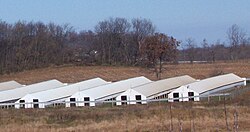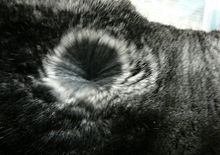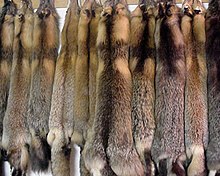Fur farming


Fur farming is the practice of breeding or raising certain types of animals for their fur.
The animal most commonly farmed for its fur is the mink. As of 2003, Denmark had the largest fur-farming industry of mink, with 35% of world production.[1] Fur farming takes place mainly in Denmark, Finland, Norway and Holland in Europe. China with its huge fur industry is the largest importer and re-exporter of fur in the world.[2]
Fur farming is banned in Austria,[3][4] Croatia (starting January 1, 2007, with a 10 year phase out period,[4][5] and the United Kingdom.[6] In Switzerland, the regulations for fur farming are very strict, with the result that there are no fur farms.[4] Some other countries have a ban on fur farming of certain types of animals.
Demand fell in the late 1980s and 1990s because of a number of factors, including the failure of designers to come up with exciting new lines, and also the efforts of animal rights campaigners. Since the turn of the millennium, however, sales worldwide have soared to record highs, fuelled by radically new techniques for working with fur, and a sharp rise in disposable income in China and Russia. This growing demand has led to the development of extensive fur farming operations in countries such as China, where activist groups such as People for the Ethical Treatment of Animals (PETA) have raised concerns about inhumane treatment of animals and the nature of some slaughterhouse practices.
History
The first fur farms in North America appeared in the 1860s. Historically, the fur trade played an important economic role in the United States. Fur trappers explored and opened up large parts of North America, and the fashion for beaver hats led to intense competition for supplies of raw materials. Starting in the latter half of the 20th century, producers and wearers of fur have been criticized because of the perceived cruelty involved in animal trapping and because the availability other natural and synthetic fibers that competed with fur.
Today, 85 percent of the fur industry's pelts come from animals raised on farms. The most farmed fur-bearing animal is the mink, followed by the fox. Chinchilla, lynx, muskrats and coyotoes are also farmed for their fur. Sixty-four percent of fur farms are in Northern Europe, 11 percent are in North America, and the rest are dispersed throughout the world, in countries such as Argentina and Russia.[7]
Various types
Mink

Mink have been farmed for fur in the United States for 130 years. In 2005, the U.S. ranked fourth in production behind Denmark, China and the Netherlands. Mink typically breed in March, and give birth to their litters in May. Farmers vaccinate the young kits for botulism, distemper, enteritis, and, if needed, pneumonia. They are harvested in late November and December. Methods for killing animals on fur farms, as on all farms, are detailed in the American Veterinary Medical Association's Report on Euthanasia which is used as a voluntary guideline for state departments of agriculture which have jurisidction over all farms raising domesticated livestock, including mink. [1]
The white mink is a breed that has, until recently, lived exclusively in northern Europe. A Canadian mink rancher Percy Verner Noble introduced the species into his farm in 1968. This development has led to a prosperous industry in the North American fur trade.
Chinchilla

The international trade in chinchilla fur goes back to the 1500s and the animal (whose name literally means "Little Chincha") is named after the Chincha people of the Andes, who wore its soft and dense fur. By the end of the 19th century, chinchillas had become quite rare. In 1923, Mathias F. Chapman brought the eleven wild chinchillas he had captured to the U.S. for breeding. Only three of these were female. Pop musician Madonna wore a chinchilla fur coat, made of an estimated 40 chinchillas in December 2006,[8] made the news in the UK when outraged animal rights groups who accused the star of ignoring the reality of how animals are farmed for their skins. [9] Empress Chinchilla is the breeders association for the chinchilla farmers, many of whom are based in the United States, including California. Empress Chinchilla runs a certification program for farmers. [2]
Fox


Finland is the world's leading producer of fox pelts. In the USA, fox production is about 10,000 pelts, produced in about 10 states. Wisconsin and Utah have the most and second most number of fur farms in the USA. Canada produces ten to fifteen times as many fox furs as the USA.[10]
Dog and cat
Feral domesticated dog and cat populations are controlled all over the world. While many countries burn the carcasses from such control measures, in many countries the meat and fur are utilized. While such products would not be acceptable to consumers in many countries, the USA banned the import, export and sale of products made from dog and cat fur, in 2000,[11] when undercover videos from the Swiss Animal Protection, PETA and the Humane Society documented dogs and cats being trucked to market without food and water, pulled from their cages, disemboweled, bashed on the ground to stun them, then hung by wires, and skinned when still alive. Italy, France, Denmark, Greece, Belgium and Australia ban the practice,[12] and a European Union ban will take effect on January 1, 2009.[13] However, many products made with dog or cat fur may be mislabeled, on purpose or accidentally.[14] Some common mislabels are:
Dogs
- Asian wolf
- gae-wolf
- Pommern wolf
- China wolf
- Sobaki
- Mongolia dog fur
- goupee
- loup d'Asie
- dogue de Chine
Cats
- rabbit
- goyangi
- gatto cinesi
- maopee
- katzenfelle
- chat de Chine
- natuerliches mittel
Rabbit

The main breed in the rabbit fur farming industry, is the Rex (Castor Rex and Chinchilla Rex). Breeding animals are kept for up to 3 years, and usually give birth twice a year. The kindle are taken from their mothers at 4 weeks old to be put in a nursery with other kindle. After this the mothers are kept separated from their kits, and they get put together only for feeding - however, it's important to note that rabbits naturally only feed their kits once a day and otherwise don't interact with them. When the kits are 7 to 8 weeks old, they are put in solitary cages, where they are kept for ca 6-7 months, and are slaughtered after they have shed their winter fur. The rabbits are kept in bare wire mesh cages. A cage for one rabbit have the floor space of ca. two shoe boxes. The mortality rate for caged Rex is 10 - 15%, mostly from respiratory disease.[15]
Another breed of rabbit, is the Orylag, which is farmed only in France. The Orylag is bred for fur and meat. They are slaughtered at ca. 20 weeks. It was genetically manipulated and developed by the Institut National de la Recherche Agronomique (INRA). The mortality rate for caged Orylag is 25 - 30%, mostly from respiratory disease.[15]
Broken bones and traumatic lesions are common when rabbits are transported to the slaughter. A small percent is also dead on arrival, often due to the rabbits being tightly packed in, with poor ventilation.[15]
Controversy
Opponents of fur farming state that, as with other large scale animal farms, the methods used on fur factory farms are focused on maximizing profits rather on the physical or psychological welfare of the animals.[16][17][18]
As with other types of large scale animal farming, living conditions of animals do vary and the extreme cases are ones of much contention. For example, according to PETA, some fur farmers pack animals into small cages, preventing them from taking more than a few steps back and forth.[16] This crowding and confinement is extremely distressing to mink — solitary animals who may occupy as much as 2,500 acres (10 km²) of wetland habitat in the wild. Life in a cage leads minks to self-mutilate — biting at their skin, tails, and feet — and frantically pace and circle endlessly. Zoologists at Oxford University who studied captive mink found that, despite generations of being bred for fur, minks have not been domesticated and suffer greatly in captivity, especially if they are not given the opportunity to swim.[19] Foxes and other animals suffer equally and have been found to cannibalize each other as a reaction to their crowded confinement.[16]
Farmers argue that young mink and foxes, such as those found on farms, are not solitary animals while young and actually do better with a "litter mate" to share a pen.[citation needed] Farmers argue that poor health and negative animal behavior on a farm has always resulted in farmers changing and improving living conditions to reach a balance between what is practical for the farmer/owner and what is beneficial for the animals.[citation needed] Farmers argue that the living conditions are optimal for the farmed animals and result in good health, growth and reproduction.[citation needed]
In other cases, as with passing of animal welfare legislation in Italy, animals are required to be "given enriched living environments in which they can climb on branches, dig holes, use a nest of 50 x 50 cm and also have a water basin of at least 2 x 2 metres and 50 cm deep in which to swim." [3]Farmers argue that 50 years ago, the animals were kept in large outdoor holding areas, with pools of water. However, such "farms" resulted in high disease rates for the animals and were not practical.
Farmers argue that today's farmed animals only know farm life. Hunters and trappers argue that the ultimate in "free range" fur comes from wild harvest where the animals live all their lives in the wild.
The methods used for killing the animals vary depending on the animal. For wild furs, biologists and wildlife managers dictate seasons, methods of kill and numbers of animals to be taken.
Mink farmers usually breed female mink once a year. The average litter is three or four kits. The pelts are harvested in the late fall, early winter with the finests animals held over until the next year to restock the farm.
In 2005, the Swiss Animal Protection (SAP) released an undercover video depicting details of a fur farm in Hebei, China in which men were seen throwing live animals to the ground and skinning them while they were still alive.[20]
Legality
Fur farming was banned in England and Wales by the Fur Farming (Prohibition) Act 2000[21] and in Scotland by the Fur Farming (Prohibition) (Scotland) Act 2002.[22] At second reading, the ban in England and Wales was justified principally on grounds of public morality.[18][23]
In Austria, six of the nine federal states have banned fur farming and in the remaining three there are such strict welfare regulations, in relation to the availability of swimming water, that fur farming is no longer economically viable.[24]
In China, there are no present laws to protect the welfare of animals bred on fur farms.[25]
In the United States there are no federal laws governing the care, treatment, or killing of animals on fur farms. Animals raised for fur are not covered under the Animal Welfare Act nor the Humane Slaughter Act. State and local laws specific to fur farms are also nonexistent.[26]
See also
- Fur
- Fur trade
- Factory farming
- Leather
- Tanning
- Animal Liberation Front
- People for the Ethical Treatment of Animals (PETA)
References
- ^ "Introduction". Viking Fur Inc. Retrieved 2008-03-24.
- ^ "What are the rules on wearing fur?". 2006-01-12. Retrieved 2008-03-24.
- ^ Europe kicks up a stink over British move to ban mink, Telegraph.co.uk, May 13, 1999
- ^ a b c Fur Farming Legislation Around The World, Infurmation.com
- ^ Fur Farmers Backed into a Corner, fashionFINLAND.com, January 2, 2007
- ^ Fur farm ban in 2003. (UK)., Agra Europe, January 4, 2002
- ^ "Fur Industry". MSN Encarta. Retrieved 2008-03-24.
- ^ "Fury at Madonna's coat of many chinchillas". The Independent. 2006-12-08. Retrieved 2008-03-24.
- ^ "Madonna's fur coat outrages animal rights groups". The New Zealand Herald. 2006-12-09. Retrieved 2008-03-24.
- ^ "Farming For Fur". Fur Commission USA. Retrieved 2008-03-24.
- ^ The trade in dog and cat fur, Happy Paws
- ^ "Betrayal of Trust: the Global Trade in Cat and Dog Fur". Humane society. Retrieved 2008-03-26.
- ^ "An Olympic disgrace". 2008-03-24. Retrieved 2008-03-26.
- ^ Md. Bill Seeks to End Mislabeling of Fur Coats
- ^ a b c "Rabbit fur: face the facts". The Coalition to Abolish the Fur Trade (CAFT). Retrieved 2008-03-28.
- ^ a b c "Inside the Fur Industry: Animal Factories". PETA. Retrieved 2008-03-24.
- ^ "Frequent Reasons for buying Fur". fur.elehost.com. Retrieved 2008-03-24.
- ^ a b "House of Commons Hansard Debates for 5 Mar 1999 (pt 6)". 1999-03-05. Retrieved 2008-03-24.
- ^ "Fur Factory Farming". Global Action Network. Retrieved 2008-03-24.
- ^ "Dying for Fur - Inside the Chinese Fur Trade". Swiss Animal Protection (SAP). Retrieved 2008-03-24.
- ^ "Explanatory Notes to Fur Farming (Prohibition) Act 2000". Office of Public Sector Information (OPSI). 2000. Retrieved 2008-03-24.
- ^ "Fur Farming (Prohibition) (Scotland) Act 2002". Office of Public Sector Information (OPSI). 2002. Retrieved 2008-03-24.
- ^ "Bont voor Dieren: Support Our Efforts for Animal Rights". Bont voor Dieren.
{{cite web}}: Unknown parameter|accessmonthday=ignored (help); Unknown parameter|accessyear=ignored (|access-date=suggested) (help) - ^ "Bont voor Dieren: Support Our Efforts to Protect Fur Animals".
- ^ "Dogs and Cats Skinned Alive for Their Fur in China".
- ^ http://www.api4animals.org/facts.php?p=452&more=1
23. http://www.hsicanada.ca/cat_dog_fur/
External links
- Fur Commission USA
- Time Line - A Brief History of the Fur Trade at White Oak Society
- Fur Industry at MSN Encarta
